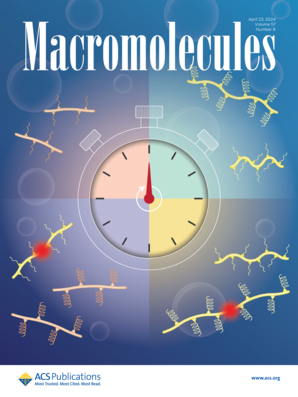Synthesis and Morphological Analysis of Well-Defined Poly(2,6-dimethyl-1,4-phenylene ether)-b-Poly(dimethylsiloxane)
IF 5.1
1区 化学
Q1 POLYMER SCIENCE
引用次数: 0
Abstract
Microphase-separated structures of block copolymers have been leveraged in advanced functional materials. However, such unique morphologies have not been extensively studied for block copolymers comprising poly(2,6-dimethyl-1,4-phenylene ether) (PPE), although PPE is a commonly utilized engineering plastic. Herein, based on precisely prepared PPE, we have developed PPE-containing block copolymers, exhibiting various microphase-separated structures such as spheres, lamellae, and cylinders. As the second block component, poly(dimethylsiloxane) (PDMS) was synthesized via living ring-opening polymerization. Block copolymers (PPE-b-PDMS) with different compositions were efficiently obtained by employing hydrosilylation using Karstedt’s catalyst. Additionally, it was found that PPE-b-PDMS followed different pathways of microphase-separated structure formation depending on the solvent used for sample preparation. The developed morphologies are expected to enhance the properties of PPE through the combination with other block components and the control of nanometer-scale internal structures.

定义良好的聚(2,6-二甲基-1,4-苯基醚)-b-聚二甲基硅氧烷的合成及形态分析
嵌段共聚物的微相分离结构已被应用于先进的功能材料中。然而,尽管聚(2,6-二甲基-1,4-苯基醚)(PPE)是一种常用的工程塑料,但这种独特的形貌尚未被广泛研究。在此,基于精确制备的PPE,我们开发了含有PPE的嵌段共聚物,具有各种微相分离结构,如球体,片层和圆柱体。采用开环活聚法制备了聚二甲基硅氧烷(PDMS)作为第二嵌段组分。以Karstedt催化剂为催化剂,采用硅氢化反应制备了不同组成的嵌段共聚物(PPE-b-PDMS)。此外,发现PPE-b-PDMS遵循不同的微相分离结构形成途径,这取决于样品制备所用的溶剂。所开发的形貌有望通过与其他块体组分的结合和纳米级内部结构的控制来提高PPE的性能。
本文章由计算机程序翻译,如有差异,请以英文原文为准。
求助全文
约1分钟内获得全文
求助全文
来源期刊

Macromolecules
工程技术-高分子科学
CiteScore
9.30
自引率
16.40%
发文量
942
审稿时长
2 months
期刊介绍:
Macromolecules publishes original, fundamental, and impactful research on all aspects of polymer science. Topics of interest include synthesis (e.g., controlled polymerizations, polymerization catalysis, post polymerization modification, new monomer structures and polymer architectures, and polymerization mechanisms/kinetics analysis); phase behavior, thermodynamics, dynamic, and ordering/disordering phenomena (e.g., self-assembly, gelation, crystallization, solution/melt/solid-state characteristics); structure and properties (e.g., mechanical and rheological properties, surface/interfacial characteristics, electronic and transport properties); new state of the art characterization (e.g., spectroscopy, scattering, microscopy, rheology), simulation (e.g., Monte Carlo, molecular dynamics, multi-scale/coarse-grained modeling), and theoretical methods. Renewable/sustainable polymers, polymer networks, responsive polymers, electro-, magneto- and opto-active macromolecules, inorganic polymers, charge-transporting polymers (ion-containing, semiconducting, and conducting), nanostructured polymers, and polymer composites are also of interest. Typical papers published in Macromolecules showcase important and innovative concepts, experimental methods/observations, and theoretical/computational approaches that demonstrate a fundamental advance in the understanding of polymers.
 求助内容:
求助内容: 应助结果提醒方式:
应助结果提醒方式:


